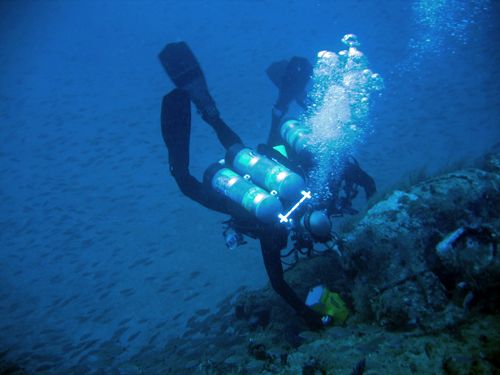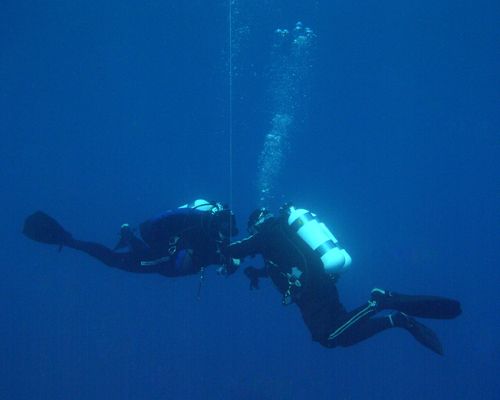Gas Laws And Scuba Diving
SCUBA Diving and Gas Laws
Polly Dornette
Product Programmer and Former SCUBA Teacher
Students are often fascinated by extreme sports such as SCUBA (Self-Contained Underwater Animate Apparatus) diving. This interest can be harnessed to teach an heady lesson on gas laws and their importance to SCUBA diving. Annotation: SCUBA diving is a sport filled with many inherent dangers and requires specialized preparation and equipment. Practise not endeavour any diving activity without proper training and certification.

© J. Robert Patrick
SCUBA diving basics
The dry air we breathe every day is equanimous of 21% oxygen, 78% nitrogen, and <ane% other gases. Its average pressure level at sea level is ane atm (14.7 psi). For SCUBA, this air is compressed into a SCUBA cylinder or "tank." SCUBA tanks tin can be made of steel or aluminum; each of these materials has pros and cons that touch the diver's determination on which type to use.
The compressed air in the tank is delivered to the diver through a regulator, which reduces the pressure from the tank to match the ambient pressure. At the surface, ambient pressure is 1 atm and it increases past 1 atm for every ten yard in depth through which a diver descends. Note: Other gas mixes such as nitrox (an oxygen/nitrogen mixture with a greater amount of oxygen than air), heliox (a helium and oxygen mixture), and trimix (a mixture of oxygen, nitrogen, and helium) or even pure oxygen are too used for technical diving, only those mixes go beyond the telescopic of this discussion.
Boyle's law: P 1 Five 1 = P ii V 2
A cardinal rule of SCUBA diving is to "never agree your breath." A look at Boyle's law explains why this rule exists. When a diver inhales air from a SCUBA tank, the air that enters the diver's lungs is at ambient pressure. If a diver inhales from the tank on the surface, the pressure in her lungs will exist at 1 atm. If she inhales air from her tank at a depth of 30 m (~99 ft), the pressure in her lungs will exist 4 atm (thirty m / 10 k/atm = 3 atm from the water plus 1 atm from the air at the surface = 4 atm). Assuming the diver's lung book is 1 50, we can complete the left side of the equation for Boyle's law. If a diver at 30 1000 has one L (5 i) of air at a pressure of 4 atm (P i) in her lungs and ascends to the surface (P two) while holding her jiff, the following equation applies:
Solving for Five 2, we encounter that the diver's lung volume would increase to 4 times its typical volume. This increase volition result in severe impairment to the lungs, which can exist fatal. The increase of volume with a subtract in pressure can also be seen in the gas bubbles exhaled by a diver equally she rises to the surface. The exhaled air bubbling are pocket-size at depth and increase in size as they travel towards the surface. See the photo.

© John Simone
After working through this example, students often enquire why gratis divers are able to swoop to such extreme depths. Free divers fill up their lungs at the surface with air at ambient pressure (P 1) so descend while holding their breath. The pressure change has the contrary touch on on the volume of their lungs. A costless diver diving to a depth of thirty k would have his lungs shrink to ¼ of their initial volume, which can be determined using the following equation:
SCUBA instructors sometimes demonstrate this principle to their students past bringing a foam cup along on a dive. As the pressure level increases with depth, the gas bubbling trapped in the foam subtract in volume, shrinking the cup.
Boyle's law also has implications on the amount of air used from the tank with each breath. At 10 chiliad (2 atm) twice as many oxygen and nitrogen molecules are inhaled with each jiff. Deeper dives require closer monitoring of a diver's air supply because the diver uses his supply more chop-chop. Another question students often ask in this discussion is, "How is the SCUBA tank impacted by these changes in pressure level?" Because the tank is a rigid container, its volume is not altered with the change in external pressure nor is the gas information technology contains affected.
Gay-Lussac'southward constabulary: P i / T one = P ii / T ii
In SCUBA diving, Gay-Lussac'southward law (sometimes referred to as Amontons' law of pressure-temperature) is almost important in relation to the amount of breathable air in a tank. The pressure of an "empty" tank is low (around 500 psi), and the temperature is equal to the ambience temperature. SCUBA tanks fabricated out of aluminum typically have a rated fill pressure of three,000 psi.
A SCUBA tank is a rigid container, therefore its volume is held constant. When a tank is filled, additional oxygen and nitrogen molecules are added to the tank and the pressure and temperature increase. If a tank is filled apace to 3,000 psi (P 1), its temperature can rise to as much as 150° F (65.6° C). Since all gas laws use accented temperatures, this temperature needs to exist converted.
Most students know they can convert a Celsius temperature to an absolute temperature of Kelvin past adding 273. Still, they are not likely to exist aware that they can add 460 to a Fahrenheit temperature to convert it to a Rankine temperature, which is based on the Fahrenheit calibration only with naught representing absolute zero. As the tank cools to ambient temperature (T two) later on the rapid fill, the gas pressure level in the tank will likewise decrease. Assuming the ambience temperature is 70° F (21° C), the following equations can be used to determine the pressure at the lower temperature:
Using the Kelvin calibration:
T 1 = 65.vi + 273 = 338.6 K
T two = 21 + 273 = 294 M
iii,000 psi / 338.half dozen K = P 2 / 294 K
P 2 = two,604 psi
Using the Rankine scale:
T one = 150 + 460 = 610 R
T 2 = 70 + 460 = 530 R
three,000 psi / 610 R = P 2 / 530 R
P 2 = 2,606 psi
Charles'south police: V 1 / T ane = V two / T 2
Charles'south law is seldom relevant to diver safety; all the same, the implications of this law are responsible for an interesting phenomenon for divers using dry suits. A dry adapt is a watertight garment worn by divers (typically over warm article of clothing) that serves to keep the diver warm by trapping a layer of air between the diver and the conform. Dry suits are commonly worn in common cold air and/or water temperatures.
During the dive, divers can add and remove air from their dry suits through their regulators. This allows them to adjust for changes in their suits' gas volumes due to pressure changes during assent and descent. If the air temperature is colder than the water temperature when the divers sally at the end of the dive, they tin can become "vacuum sealed" in their suits due to the decrease in their suits' gas volumes. Divers tin add air to the suits from their tanks, or unzip their suits, to release the "squeeze."
Dalton'southward law: P Total = P i + P 2 + P three . . .
Likewise known every bit Dalton'southward law of fractional pressures, this police states that the full force per unit area of a gas mixture is equal to the sum of the fractional pressures of its component gases. As mentioned before, dry air is a mixture composed of 21% oxygen and 78% nitrogen. Both of these gases tin have negative impacts on a diver at high pressures. Low partial pressures of oxygen are also dangerous simply are just an consequence for technical diving, which is beyond the scope of this discussion.
Oxygen can get toxic to a diver when the fractional pressure of the oxygen breathed is higher up 1.6 atm. Symptoms of oxygen toxicity can include changes in vision, dizziness/vertigo, and seizures, all of which can be problematic for a diver and tin can lead to expiry. To summate at what depth a diver might brainstorm to experience symptoms of oxygen toxicity when diving with compressed air, we demand to commencement calculate at what air force per unit area would the partial pressure of oxygen be equal to 1.6 atm or greater.
At 1 atm of total pressure for air, oxygen would have a fractional pressure level of 0.21 atm. Therefore, the full force per unit area of the air would be 7.six atm (1.6/0.21 atm) for the partial pressure level of oxygen to exist at 1.half dozen atm or greater. Remember that for each 10 m of depth the pressure increases by 1 atm, just the pressure at the surface is 1 atm, so the fractional pressure of oxygen in air would be i.6 atm at 66 m (216 ft).
Nitrogen narcosis can result from a diver's exposure to loftier fractional pressures of nitrogen during her dive. Symptoms of nitrogen narcosis most closely resemble those of alcohol intoxication. These symptoms announced more than gradually than those of oxygen toxicity just likewise increase with depth.
Henry's constabulary
Henry'southward law states that the concentration of a gas dissolved in a liquid at a given temperature is directly proportional to the partial pressure of the gas above the liquid. The implication of this law for SCUBA diving is that as depth increases (and therefore pressure) the amount of a gas dissolved in the diver'south blood will besides increment. Oxygen is consumed past the body'southward physiological processes, simply nitrogen is physiologically inert. The longer that a diver remains at depth, the more nitrogen is dissolved in his blood.
During long dives a considerable corporeality of nitrogen can be dissolved in the diver's bloodstream. When the diver ascends the partial pressure level of nitrogen drops, and due to Henry's police the dissolved nitrogen begins to come out of solution. Nitrogen bubbles class in the diver's bloodstream, which can lead to decompression sickness (DCS).
The symptoms of DCS and their severity depend on where in the diver's body the bubbles drift and tin can range from soreness in the joints or blisters nether the skin to expiry. Treatment for DCS typically involves several sessions in a hyperbaric oxygen chamber. In their preparation, divers are taught to stay within dive time and depth limits to minimize their risk of DCS and to ascend slowly from every dive.
Related products
For further exploration of the gas laws, we recommend the following products:
- Spouting Cylinder (item #752529)
- Inquiries in Science®: Expanding on the Gas Laws Kit (item #251205)
- Carolina Stem Claiming®: Cartesian Divers Kit (item #750024)
Gas Laws And Scuba Diving,
Source: https://www.carolina.com/teacher-resources/Interactive/scuba-diving-and-gas-laws/tr29802.tr
Posted by: bennettwasat1989.blogspot.com


0 Response to "Gas Laws And Scuba Diving"
Post a Comment